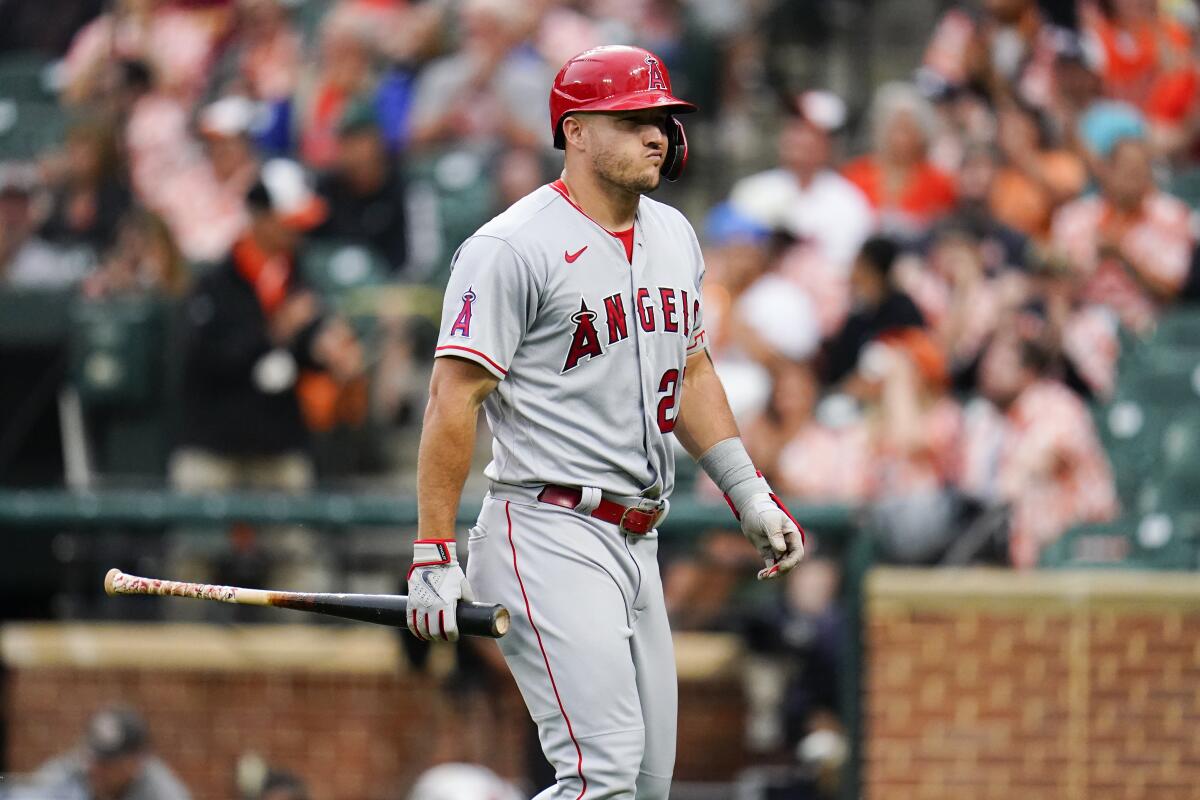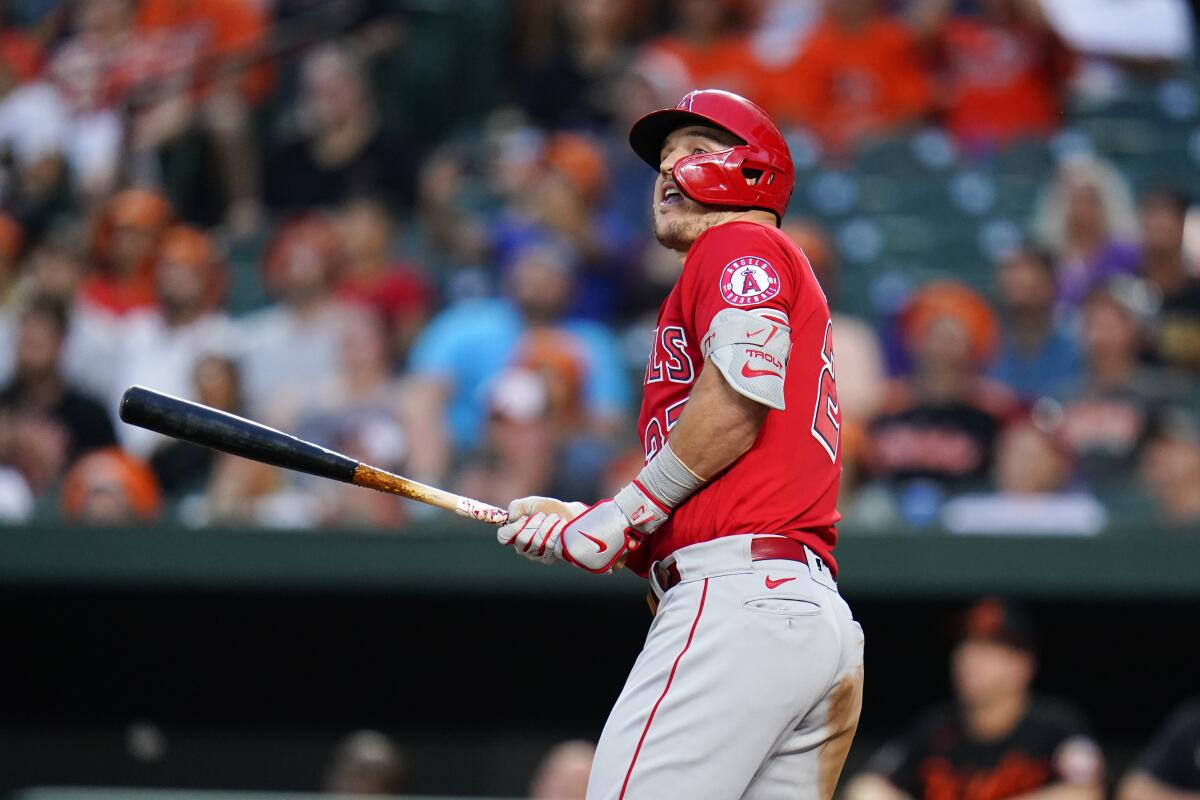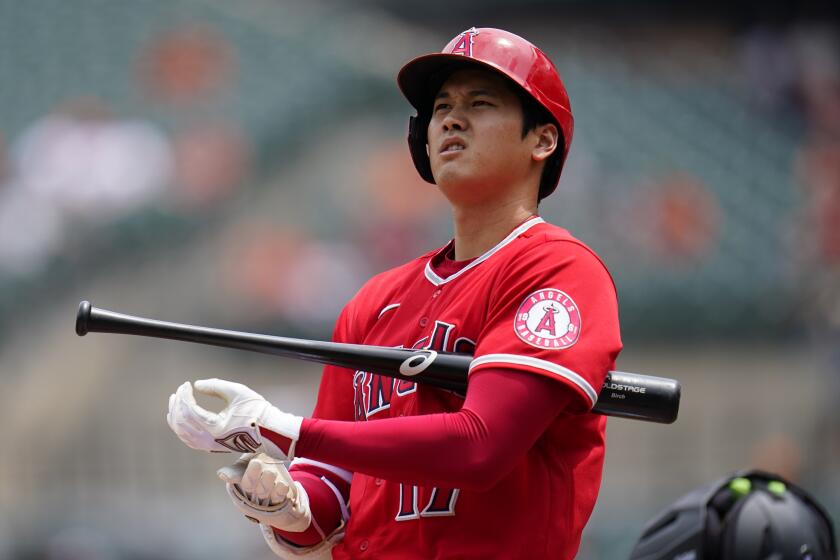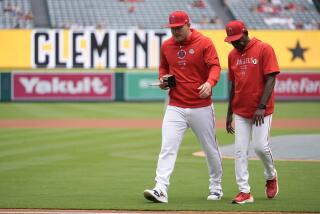Angels’ Mike Trout susceptible again to high fastballs. What is going on?

- Share via
Three times Mike Trout strode to the plate against Houston pitcher Jose Urquidy on July 2, and three times he returned to the dugout in frustration, the Angels star striking out on three pitches in each at-bat, the equivalent of an immaculate inning by the Astros right-hander against one of baseball’s best hitters.
There was no trickery involved in the whiffs. Urquidy’s first pitch to Trout that day at Minute Maid Park was a curveball. His next eight pitches were 93-95 mph fastballs, seven of them in the upper third of the strike zone.
High heat. This was Trout’s kryptonite in 2014, when he won his first of three American League most valuable player awards despite a career-high 184 strikeouts, and it is a glaring weakness again in 2022, even as Trout compiles another All-Star season after sitting out most of 2021 because of a calf strain.
Trout has always crushed breaking balls in the zone, with a major league-leading .866 slugging percentage on such pitches since the start of the 2018 season.
But he entered Wednesday night’s game against the Astros with an .064 average in plate appearances ending with high fastballs this season, managing three singles in 47 at-bats with 27 strikeouts, according to Baseball Savant.
Here are all the answers to the questions you might have about joining some of the action for MLB All-Star Game week in Los Angeles.
Those struggles have contributed to Trout striking out 97 times in 79 games, tied for ninth-most in the majors, and a career-high strikeout rate of 29.8%, well above his 26.1% strikeout rate of 2014 and his career average of 21.9%.
“I haven’t been in a good spot at the plate, and usually when I’m in a good spot, I either don’t swing at those pitches or I get to them,” Trout said before Tuesday night’s game, in which he struck out twice before departing because of upper back spasms. “If I’m in a good spot and seeing the ball, we’re not even talking about this.”
Trout entered Wednesday with a .270 average, .967 on-base-plus-slugging percentage, 24 homers and 51 RBIs this season, but he has endured two unusually lengthy slumps, an 0-for-26 skid in early June and a one-for-25 skid in early July. He is on pace for 177 strikeouts.
The center fielder hit .287 with a .939 OPS, 36 homers and 111 RBIs in 2014, but his inability to combat high heat contributed to his 184 whiffs. On pitches in the upper third of the zone that season, Trout batted .082 (nine for 110) with two homers, 39 strikeouts and a swing-and-miss rate of 36.2%, according to Pitch F/X data.
Trout mitigated that weakness the following season, learning to lay off, foul off or square up more high fastballs. He incorporated practice drills in which he elevated the tee for some swings and had soft tosses thrown higher to force him to stay on top of the ball.
The results were tangible. Trout hit .243 (88 for 362) with a .793 OPS and 22 homers on high fastballs from 2015 to 2021, including a high mark of .351 (13 for 37) with three homers in 2016, according to Baseball Savant.
But Trout has had little success against high heat this season, and opponents have been relentless in their attempts to expose the soft spot.

In nine games on the Angels’ recent trip to Houston, Miami and Baltimore, 123 of the 161 pitches to Trout were fastballs, including 12 high heaters on which Trout struck out, flied out or grounded out.
“That’s where a lot of guys can get any hitter out — the elevated heater, the plus-velocity, the ride that’s coming with it and being able to hit that location over and over again,” Angels hitting coach Jeremy Reed said. “Mike’s very well aware of how they attack him, how they can get him out with certain things.
“It’s definitely something he works on in the cage, getting above that pitch, but it’s also one of the hardest pitches to lay off of for most hitters. If it’s a ball [above the zone], you gotta lay off it because it has so much velo.”
In addition to his usual tee work and soft-toss drills, Trout often hits high fastballs off the high-velocity pitching machine.
“It’s not one particular drill that’s gonna get you there,” Trout said, “but I’m definitely doing stuff that I did in the past.”
Trout’s batting average against high heat is one of several anomalies on his stat line this season.
Trout entered Wednesday with a major league-best 1.194 OPS at home but a meager .738 OPS on the road, even with his one-man-wrecking-crew of a series at Seattle, when he hit five homers and drove in nine runs in five games against the Mariners on June 16-19. (His career splits for OPS are 1.022 at home and .979 on the road.)
“I couldn’t tell you why,” Trout said of the 456-point OPS differential this season. “It’s a freak thing.”
Trout’s fly-ball rate (46.5%) is almost twice as high as his ground-ball rate (23.8%) this season and far higher than his career fly-ball rate of 30.1%.
The Angels have the worst record in the major leagues since May 25. Should they trade Shohei Ohtani to jumpstart a rebuild? Baseball experts weigh in.
“Yeah, I noticed that, too,” Trout said. “Couldn’t tell you why. I have no idea.”
This wouldn’t be as much of a problem if baseballs were flying like they were a few years ago, but with all 30 teams storing baseballs in humidors, reducing the balls’ bounciness and traveling distance, more of Trout’s long flies are dying on the warning track instead of clearing the wall.
“Before,” Trout said, shaking his head, “they’d be home runs.”
It’s just one of a growing number of ways in which the sagging Angels (38-50) are falling short.
More to Read
Go beyond the scoreboard
Get the latest on L.A.'s teams in the daily Sports Report newsletter.
You may occasionally receive promotional content from the Los Angeles Times.









